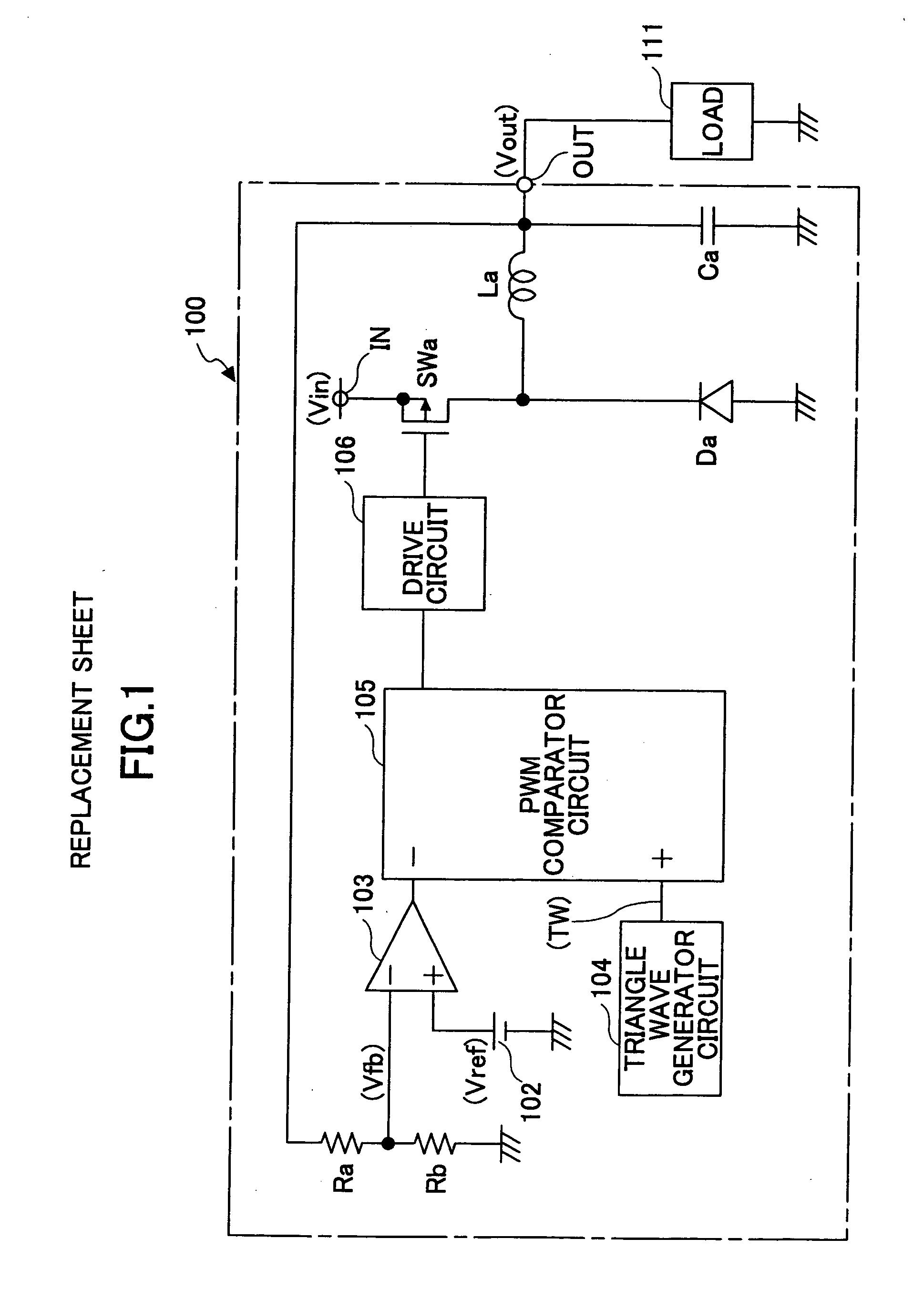Step-down switching regulator
a switching regulator and step-down technology, applied in the direction of electric variable regulation, process and machine control, instruments, etc., can solve the problems of reducing efficiency at a light load time, difficulty in interrupting a current backflow by turning off the switching device swb, etc., to achieve the effect of quick change of output voltage and improved efficiency
- Summary
- Abstract
- Description
- Claims
- Application Information
AI Technical Summary
Benefits of technology
Problems solved by technology
Method used
Image
Examples
first embodiment
[0024]FIG. 2 is a circuit diagram showing a step-down switching regulator 1 according to a first embodiment of the present invention.
[0025] Referring to FIG. 2, according to the switching regulator 1, a supply voltage supplied from a DC power supply (not graphically illustrated) such as a battery is input to an input terminal IN as an input voltage Vin, and a predetermined constant voltage is generated from the input voltage Vin and output from an output terminal OUT to a load 10 as an output voltage Vout.
[0026] The switching regulator 1 includes a switching device SW1 formed of a PMOS transistor, a switching device SW2 for synchronous rectification formed of an NMOS transistor, an inductor L1 and a capacitor C1 for smoothing, and resistors R1 and R2 for output voltage detection. The switching device SW1 performs output control of the input voltage Vin input to the input terminal IN. The resistors R1 and R2 generate a divided voltage Vd1 by dividing the voltage Vout output from th...
second embodiment
[0039] According to the above-described first embodiment, the output voltage Vout is changed by changing the value of the reference voltage Vr. Meanwhile, according to a second embodiment of the present invention, the reference voltage Vr is constant while the divided voltage Vd1 is changed by an external analog-level signal. In this case, the reverse current detector circuit part 8 of FIG. 2 may detect a change in the setting of the output voltage Vout by detecting the analog-level signal. This configuration is employed in the second embodiment.
[0040]FIG. 4 is a circuit diagram showing a step-down switching regulator 1a according to the second embodiment. In FIG. 4, the same elements as those of FIG. 2 are referred to by the same numerals, and a description thereof is omitted. With respect to FIG. 4, a description is given of the differences from FIG. 2.
[0041] In FIG. 4, the differences from FIG. 2 are as follows. The D / A converter 2 of FIG. 2 is replaced by a reference voltage g...
third embodiment
[0048] A description is given of a third embodiment of the present invention.
[0049] In each of the first and second embodiments, the switching device SW1 may turn ON to output the input voltage Vin while the output voltage Vout is set to be higher than or equal to the input voltage Vin, and / or the gate-source voltage of the switching device SW1 may be reduced to limit output current when more current than expected flows from the output terminal OUT because of occurrence of an abnormality such as short-circuiting of the output terminal OUT. This configuration is employed in the third embodiment.
[0050]FIG. 5 is a circuit diagram showing a step-down switching regulator 1b according to the third embodiment. FIG. 5 shows a configuration based on the configuration of FIG. 2 by way of example. In FIG. 5, the same elements as those of FIG. 2 are referred to by the same numerals, and a description there of is omitted. With respect to FIG. 5, a description is given of the differences from F...
PUM
 Login to View More
Login to View More Abstract
Description
Claims
Application Information
 Login to View More
Login to View More - R&D
- Intellectual Property
- Life Sciences
- Materials
- Tech Scout
- Unparalleled Data Quality
- Higher Quality Content
- 60% Fewer Hallucinations
Browse by: Latest US Patents, China's latest patents, Technical Efficacy Thesaurus, Application Domain, Technology Topic, Popular Technical Reports.
© 2025 PatSnap. All rights reserved.Legal|Privacy policy|Modern Slavery Act Transparency Statement|Sitemap|About US| Contact US: help@patsnap.com



